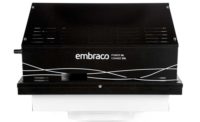When the Doral Costa Office Building was being designed, it didn’t really start as a blank slate. That’s because the developer knew one thing for sure: He didn’t want any mechanical equipment located inside the building.
After looking at the remaining options, it seemed that rooftop units would be the best choice for this $12 million, four-story, 135,000-square-foot office building. Choosing the HVAC contractor wasn’t really an issue either; AA Advance Air Inc., Pompano Beach, Fla., had previously worked on a similar building with both the developer and the general contractor, Itasca Construction Associates, Boca Raton, Fla.

Getting Started
AA Advance Air is a locally owned company that has been in business in Pompano Beach since 1976. The company specializes in air conditioning contracting, installation, and service throughout south Florida. With president Robert Burrow at the helm, AA Advance Air works in new commercial and residential construction and is also active in the retrofit and planned maintenance markets.At the beginning of 2002, the general contractor contacted Burrow about the potential HVAC equipment for the Doral Costa building. The developer planned for the building to be used by a large number of people, and air conditioning requirements for the south Florida project were especially demanding.
“They were looking for heavy-user tenants with a high density of people, like that found in an insurance firm,” says Burrow. “They wanted 100 percent redundancy in the air conditioning system, as well as variable air volume (VAV) and building management systems.”
The key was that the developer wanted all the mechanical equipment (except the VAV boxes) on the roof. “We’d done this before on another building, and the developer liked the concept,” says Burrow. “This way, you don’t have to worry about doing any heavy maintenance inside the building — not to mention you have no water inside the building, so you don’t ever have to worry about a water leak from a coil, or having to clean a coil inside the building,” notes Burrow.
Choosing The Equipment
AA Advance Air ended up installing four 130-ton Trane “Intelli-Pak” rooftop units. Each of the two sets of units is paired with an emergency bypass duct and an automatic damper that opens in case one of the units goes down. This arrangement provides the 100 percent redundancy required by the developer.Trane VAV boxes and “Tracer” controls were installed. Burrow had used this combination of equipment on eight different buildings, and it worked out well, so he decided to stick with the same arrangement. “The developer also liked that all the equipment came from a single source,” says Burrow.
The rooftop units have double-wall construction and environmental drain pans. “The units are also equipped with track dampers,” says Burrow. “Typically on a VAV system, if you’re operating at 50 percent, your fresh air starts to drop off. With the track damper system, it’s always measuring the outside air coming into the building, and it will reduce the return air so that the required amount of outside air going into the building is always maintained.”
This was an important feature to the developer, because the amount of outside air entering the building can be documented through the Tracer building management system. If there’s ever a question about proper amounts of outside air, the developer will have documented proof that sufficient quantities were being introduced to the space.
Because the equipment came from a single source, Burrow experienced no interoperability problems with the building management system and HVAC equipment. “The rooftop units have factory-mounted variable-speed drives, so all the components were in place,” he says. “All we had to do was loop the wire from one component to the next. It was all very easy.”
Water Not An Option
Burrow says the developer was never interested in a chilled-water system. “They always really liked having four completely stand-alone machines. It was a fairly large building for this application, in the fact that it’s four stories with rooftop packaged units. That’s a bit unusual for our market,” says Burrow.The developer also liked the fact that all maintenance would be performed on the roof. Burrow agrees, noting that it’s often easier to access the equipment on a rooftop than it is to traipse through a building carrying all the necessary gear. And since AA Advance Air has a service agreement for the building, that’s an important consideration.
As can be imagined, those rooftop units weigh a lot, so extra heavy reinforcement was required for the roof. In addition, a crane was required to place the equipment on top of the building, but since the structure is only four-stories tall, it wasn’t too difficult.
The developer was pleased with the finished product, and so is Burrow. “It’s a good type of work for us, because the customer winds up happy. The rooftops are packaged units,” he says, “so they’re completely factory assembled with the variable-speed drives mounted. It’s a single connection for the electrical contractor. This arrangement works out well for this type of building.”
Publication date: 06/23/2003



